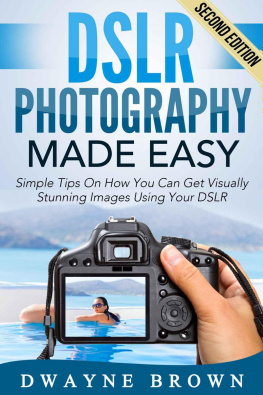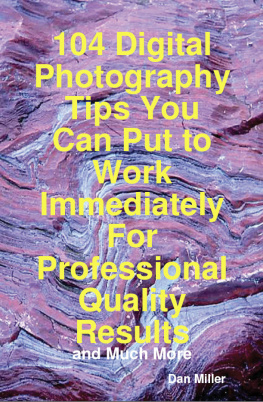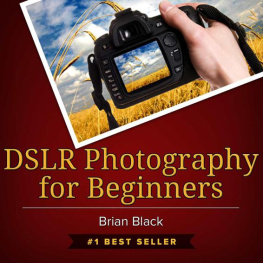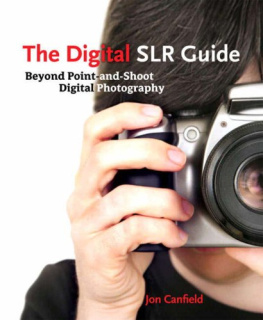I want to thank you and congratulate you for downloading the book , DSLR Photography Made Easy: Simple Tips on How You Can Get Visually Stunning Images Using Your DSL R .
This book contains proven steps and strategies on how to take visually stunning pictures using a DSLR camera.
With the advent of the information age, people have become more and more expressive of their thoughts and emotions. This is why blogging and social networking sites have become so popular.
Along with this trend is the sudden popularity of photography. With more and more professional-level cameras being made available to the public, more and more people have begun to pick up on this strangely satisfying hobby.
But just having a DSLR doesnt make someone a photographer. Anyone with a camera can take a picture. It takes a real photographer to take a good shot. This is what this manual was made for.
This book has been designed to walk you through the hobby of photography and how to deal with your newly-purchased DSLR camera. In order to take great pictures, you will need a great understanding about how your equipment works.
Apart from that, this book will also show you some of the secrets used by the most successful photographers for whom taking breath-taking shots is as easy as breathing. Combine well-grounded knowledge of DSLR technology and expert tips from the best in the industry and you will end up with album upon album of memorable pictures that will make your proud.
Be sure to take the time to read through each chapter as they were designed to be taken like a step-by-step approach to DSLR photography. Each chapter will prepare you for the following section so that you do not get lost in the middle.
Thanks again for downloading this book. I hope you enjoy it!
Copyright 2015 by Dwayne Brown - All rights reserved.
This document is geared towards providing exact and reliable information in regards to the topic and issue covered. The publication is sold with the idea that the publisher is not required to render accounting, officially permitted, or otherwise, qualified services. If advice is necessary, legal or professional, a practiced individual in the profession should be ordered.
- From a Declaration of Principles which was accepted and approved equally by a Committee of the American Bar Association and a Committee of Publishers and Associations.
In no way is it legal to reproduce, duplicate, or transmit any part of this document in either electronic means or in printed format. Recording of this publication is strictly prohibited and any storage of this document is not allowed unless with written permission from the publisher. All rights reserved.
The information provided herein is stated to be truthful and consistent, in that any liability, in terms of inattention or otherwise, by any usage or abuse of any policies, processes, or directions contained within is the solitary and utter responsibility of the recipient reader. Under no circumstances will any legal responsibility or blame be held against the publisher for any reparation, damages, or monetary loss due to the information herein, either directly or indirectly.
Respective authors own all copyrights not held by the publisher.
The information herein is offered for informational purposes solely, and is universal as so. The presentation of the information is without contract or any type of guarantee assurance.
The trademarks that are used are without any consent, and the publication of the trademark is without permission or backing by the trademark owner. All trademarks and brands within this book are for clarifying purposes only and are the owned by the owners themselves, not affiliated with this document.
Chapter 1 - What Did I just Buy?
Its the man that makes the clothes and not the other way around.
The same thing can be said about cameras. No matter how technologically-advanced your equipment may be, your shots will only be as good as how well you handle the camera and composed your photographs.
Unfortunately, cameras are slightly more complex than clothes. And understanding how your new DSLR works is one of the most important steps you should take before getting those studio-quality shots.
THE BASICS
The acronym DSLR stands for Digital Single-Lens Reflex. Understanding this term will help you better appreciate what makes a DSLR camera different from anything else.
As opposed to thinking of a camera with a complex array of lenses, the term single-lens refers to the notion that both the photographer and film (or digital image capturing surface) are looking through the same lens. There is no distortion between what the photographer sees and what will appear on the picture.
As compared to earlier cameras that have a separate set of lenses for the eyepiece and the film, SLR cameras allow photographers to see exactly how the picture will turn out before hitting the shutter! Older cameras do not have this function because the eyepiece is separate from the camera lens.
This feature allows photographers to judge the quality of their images even before calling the shot. They can adjust the light, change the lens, re-adjust the focus and anything else they feel that will help make a better shot.
That explains the SLR part.
Take note that there are non-digital SLR cameras that still use film. Thats why they are simply called SLRs. The difference between SLR cameras and DSLR cameras is how the cameras capture the image.
Both SLR and DSLR cameras host a single lens through which the light rays pass through. While the shot hasnt been taken, the light rays from the primary lens hit a mirror tilted at a 45 degree angle. This will cause the light rays to go upward instead of hitting the rear portion of the camera.
When the now-vertical light rays bounce upward, they encounter a small system of prisms that direct the light rays to a smaller outlet known as the eyepiece. This is where the photographer sees the image before being shot. Since the user is being fed the light rays directly from the main lens, they get an exact preview of how the image is going to come out.
When the user hits the shutter, the mirror that bended the light at 45 degrees flips upward, blocking the prism system at the top which allows the light to pass right on through to the rear portion of the camera.
This is where the difference between SLRs and DSLRs come in. Instead of having the light rays hit a sheet of film to capture the image, DSLRs host a digital-imaging sensor that captures the image and translates it into a digital image to be saved unto a storage device. Once the shot has been taken, the mirror slips back into original 45 degree angle spot to once again redirect light back to the eyepiece.
The combination of these mechanisms makes DSLR and SLR cameras a really good option for the professional photographer. It saves them time and film because they get a preview before getting the image. As a hobbyist, you stand to gain a lot of convenience from using a DSLR camera.
A good step for any beginner would be to take a look at the manual. Although the mechanisms behind a DSLR camera are common for all models, different manufacturers have different blueprints for production. Find out how to switch in between modes and adjust the various settings on it.
Another important thing to look out for is the interface. Most digital cameras will now come with a user interface found underneath the eyepiece. This interface comes in the form of a digital screen from which you can toggle the different settings on your DSLR. Based on your manufacturer, your interface will also differ. Try to get acquainted with it first so that you can navigate through your camera with ease.













